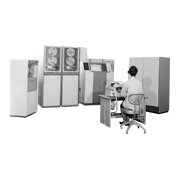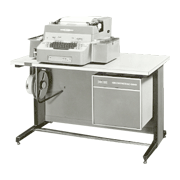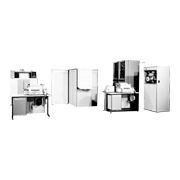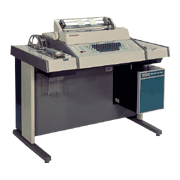The OKIMINITAC5000, announced by Oki Electric industry in 1966 as a computer for office use, performed both real-time and batch processing for billing, and was capable of simultaneously processing different jobs with up to 8 OKITYPER typewriters. To achieve this functionality, the main memory unit was 16 kilobytes magnetic core, and sorting processing was done with a 67 kilobytes magnetic drum.
The OKIMINITAC500, which was marketed next in 1967, was capable of simultaneous and automatic calculation and making table generation, and the necessary data could be output to paper tape for linking with a large electronic computer or for transferring data. Processing procedures used a system which 10 types of instructions were combined, and stored in memory from a program board. The front panel of the OKIMINITAC500 was equipped with program select switch panel, for truncating up/down and rounding, a comma insertion, a constant/date, a constant dial, print digit dial and truncate digit dial. A program patch board was housed in the lower pocket, and by using these switches and the program patch board, we could to generate multiple bills together with the OKITYPER.
The OKIMINITAC710, which used the stored program system, was marketed in 1971, and was not limited to billing processing. It was used for a wide range of clerical tasks, including classification and tabulation. ICs were used throughout for arithmetic units, and the design was compact, housing the main unit in the bottom of the typewriter. The system also allowed for paper tape input/output, and was equipped with a numeric keypad. The memory unit stored 400 words, and the number of instructions was 32.
| OKIMINITAC5000 | ||
|---|---|---|
| Announcement date | 1966 | |
| *Central processing unit | Control system | Stored program system |
| Arithmetic element | Transistors, diodes | |
| Memory element | Magnetic core: 8,192byte, 16,384byte Magnetic drum: 67,528byte |
|
| Cycle time | Magnetic core: 4µsec | |
| Access time | Magnetic drum, Average 20µsec | |
| Data format | byte (8bit parity) | |
| Word format | Variable length, Fixed length | |
| Index register | 2 | |
| Number of instructions | 59 | |
| Interrupt processing | Input/Output operation end interrupt, Terminal key interrupt | |
| *Typewriter bill printing | Printing speed | 500char/min |
| Paper tape reading speed | 500char/min | |
| Paper tape perforation speed | 500char/min | |
| Kinds of movable type | Max. 144 | |
| Edge card | Usable | |
| *Photoelectric tape reader | Code | 6 unit, 8 unit |
| Reading speed | 200char/sec or 400char/sec | |
| *High-speed tape punch | Code | 6 unit, 8 unit |
| Reading spee | 1,500char/sec or 5,000char/sec |
|
| *Line printer | Printing system | Flying belt system |
| Printing speed | 270lines/min | |
| Characters per line | 120 | |
| *Magnetic tape unit | Recording density | 200bit/inch |
| Reading speed | 190cm | |
| Winding speed | 380cm | |
| Tape length | 2,400 feet | |
| Information transfer speed | 15KB | |
| OKIMINITAC500 | ||
|---|---|---|
| Announcement date | 1966 | |
| Processing system | Programmed system | |
| Circuit composition | Static clock pulse (20kc/s) synchronization system using transistors and diodes | |
| Number representation |
Fixed point system Binary coded decimal Signal serial/parallel transfer |
|
| Arithmetic |
Addition/Subtraction, 10-digit result, Speed 0.5ms Multiplication, 10-digit result, Average 12.4ms, Max. 45.5ms |
|
| Constants | Freely selectable to type out 6 digits in one set, or to use for calculation | |
| Number of printing digits | 1~10 | |
| External dimensions | 190mm(W)×485mm(D)×357mm(H) | |





